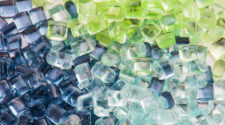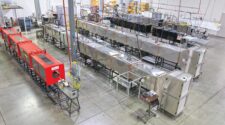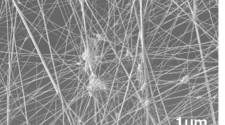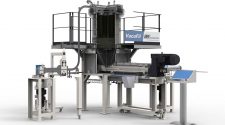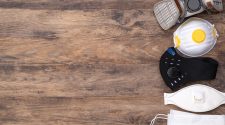There’s more to selecting the right wire filtration mesh than its micron retention rating. Filtration designers would love to depend on certain known quantities from which to start a new filter product design. Unfortunately, wire mesh is not one of them. The qualities of wire mesh often defy the typical physical qualities that more compliant materials possess. There are so many weave patterns to choose from, each with its own set of performance qualities; then, there are the inevitable compromises between a desired aperture for optimal flow and the final product’s durability in operating conditions; and finally, forming wire mesh into a fabricated product is nothing like fabricating with solid materials.
To better understand the complexities of mesh selection overall, we will consider a limited example of just a 60-micron filtration rating. By isolating a specific micron rating, we can look at all the other variables that influence filtration mesh selection.
When seeking a 60-micron mesh that also meets the designer’s durability and configuration specifications, in order to recommend the right one, the mesh supplier will have several questions. Some of these are likely more commonly understood than others:
• How much differential pressure will the mesh be subjected to?
• What is the desired volumetric flow rate through the mesh?
• How will the mesh be mounted? Will it need a support structure?
• Will it need to be pleated, punched, or formed?
• Will the edges be welded, crimped, glued, hemmed, or over-molded with plastic?
• How will all this be implemented for manufacturability, accounting for material cost and availability?
After considering responses to these questions, a knowledgeable mesh expert will consider a variety of nominally 60-micron mesh weaves and a few close matches. They’ll think about which one’s unique characteristics would make it the most suitable one for the application.
How do these weaves differ relevant to filter applications?
Table 1 shows nine different types of wire mesh weaves, all of which have close to a 60-micron retention. Comparing these weaves, the first four are what most people think micronic woven filter mesh is: a square weave, like the familiar bug screen, only finer. In fact, square meshes that fine tend to be too fragile for most filtration applications. Research shows that prior to reaching out to a mesh expert, only about 1-in-5 engineers are aware that different mesh weaves other than square weave exist.
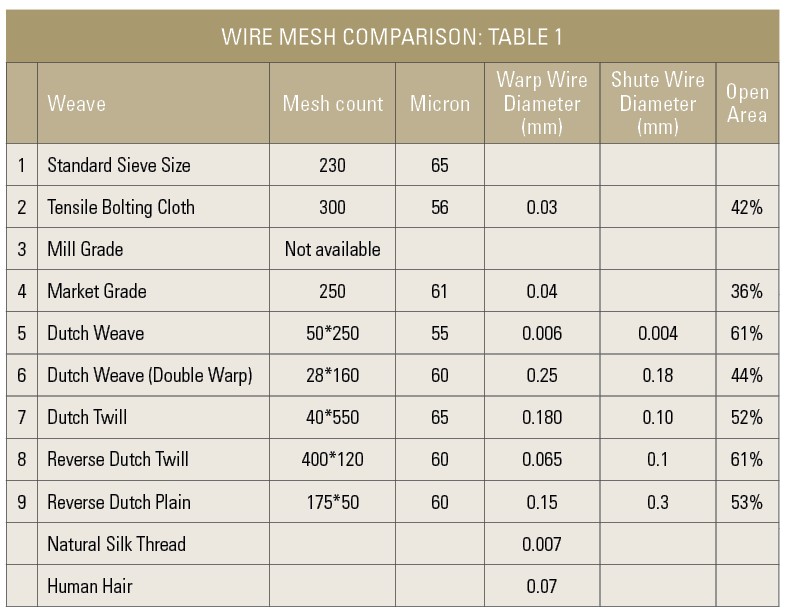
The Dutch Weave Family
A variety of Dutch weave meshes were developed to be more durable than square weaves for filtration. A Dutch weave is one in which the warp wire is larger than the shute wire, and a reverse Dutch weave is one in which the warp wire is smaller than the shute wire. With these weaves, the larger, more widely spaced wires add strength while tightly spaced smaller wires maintain the micron retention. The complexity of these weaves means that predicting how easily fluid passes through the mesh is more complicated than just measuring the open spaces between wires. Instead, flow resistance must be determined by either:
- comparing flow rates of a sample compared to a calibrated standard, then calculating the pressure-drop coefficient for that mesh, or
- by real-world measurement of the pressures on either side of the mesh in situ.
Managing the Balance Between Filter Aperture and Durability
It is clear from Table 2 that although the micron retention rating may meet specification, some of the mesh weaves will not be durable enough to meet the specified pressure, or the lifetime of wear and tear on the filter. When designing a wire mesh filter assembly, these two variables are connected, and the trade from these plays a large part in correct mesh selection.
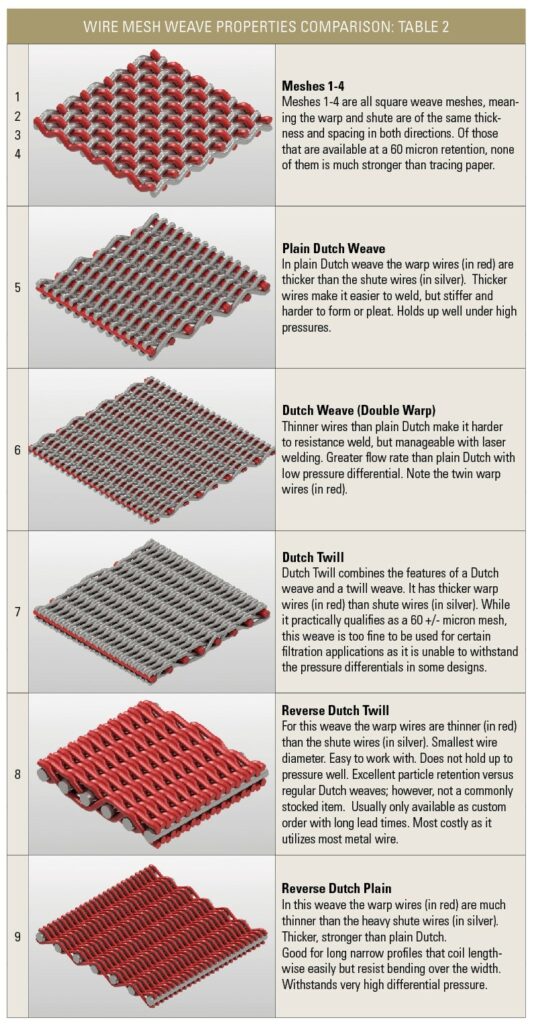
Mesh filter durability is affected in four different ways: sustained high pressure, repeated pressure fluctuations, corrosion, and operator error when cleaning and servicing the filter.
Sustained Pressure
As particles caught by the micron mesh filter gradually block the screen, the back pressure will increase. In some instances, the operation of the system calls for periodic deblinding before the pressure exceeds a threshold beyond which the mesh suffers damage. Left unattended, this pressure could simply exceed burst pressure, which is a durability catastrophe. Before burst pressure is reached, however, less noticeable system failure can occur, such as exceeding a bypass valve setting, which could allow unfiltered fluid and solids where they are not wanted. Better design can raise the damage threshold of the filter, and better maintenance adherence can prevent the mesh from suffering damaging pressures to begin with.
Repeated Pressure Cycling
In a properly designed and maintained filter system, the durability of the micron mesh should not be significantly compromised by normal use and operation. In addition to considering the effects of constant pressure on a mesh filter, the frequency of pressure changes must be considered as well. A mesh that can handle a constant pressure of 100 psi could fail quickly from oscillating between 0 and 50 psi.
Pressure oscillations such as from a diaphragm pump or an automated system repeatedly triggering a backflow cleaning cycle can compromise the mesh by work-hardening the wire far sooner and with less overall pressure differential than a system with a steady pressure.
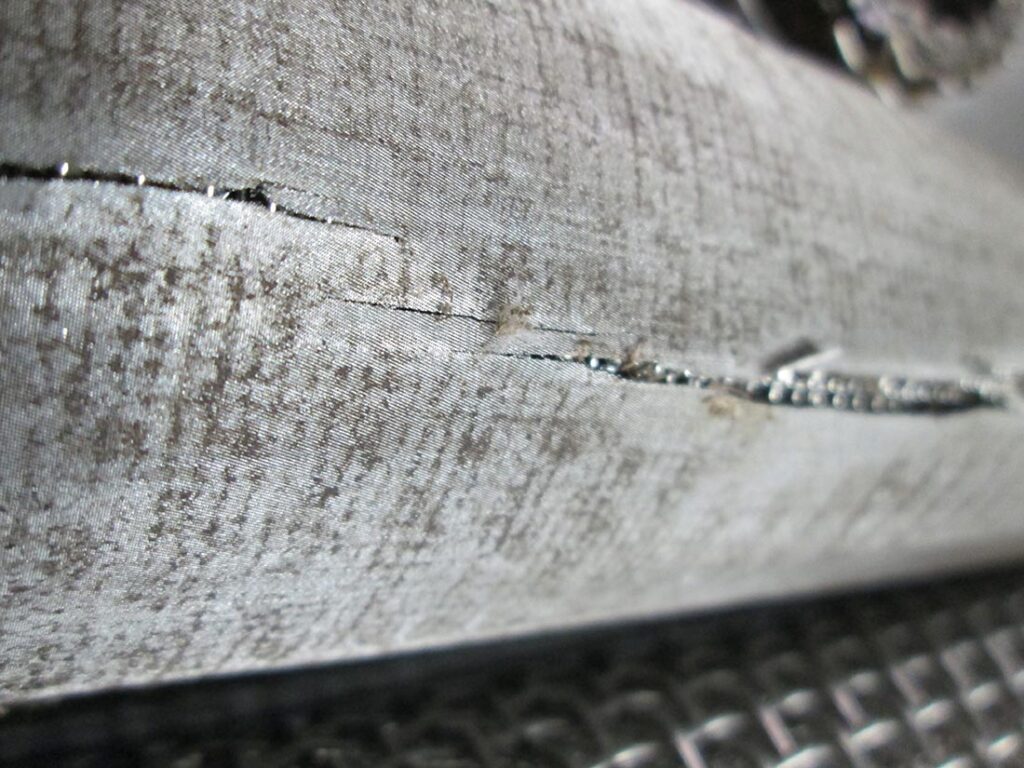
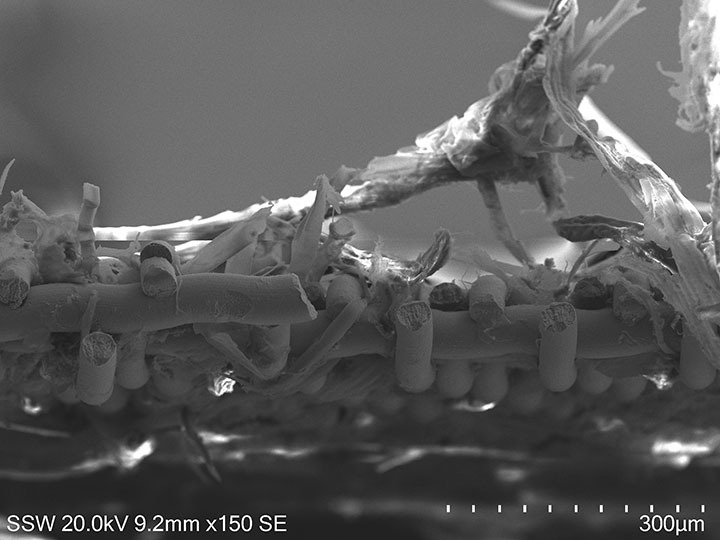
Overhandling
Over the course of a filtration session the micron mesh is slowly blocked by particles. This reduces the volumetric flow rate through the filter or results in differential pressure building until the same volumetric flow rate is achieved through brute force. The added pressure can cause wear and damage to the mesh. Alternatively, the filter will need more frequent cleaning and maintenance, increasing the opportunities for wear and tear to the mesh through handling (or mishandling). The loss of production time can also have a significant economic impact.
Start with Durability in Mind
- Don’t make your filter work harder than it must. Choose a micron mesh with a particle retention no smaller than necessary.
- Instead of selecting a micron filter mesh with the greatest possible flow rating, consider one with the same micron retention size but with a more robust construction, even if it means increased overall surface area of mesh will be needed. It will last longer and require less maintenance.
- Establish maintenance protocols that minimize chances of damaging the mesh filter or construct the filter to stand up to some rough handling.
- Another way to strengthen the mesh is to reduce the possibility that the wires in the mesh can shift around relative to one another. This is called fixing the aperture of the mesh, which reduces the likelihood that manufacturing methods, pressure spikes, or operator mishandling will deform the mesh or distort its aperture. Ways to fix the aperture include calendaring, heat treating or sintering the mesh.
Some of the more robust Dutch weave meshes are too stiff for a pleating machine, whereas others are too thin for a welding machine. One mesh might have a 1% improvement in flow rate but a 500% increase in cost.
Manufacturability
Forming the Mesh into the Shape of the Filter Assembly
If the calculated surface area of the wire mesh required is less than space allotted in the filter housing, it will need to be formed by either rolling, pressing, stamping or pleating the mesh into a shape necessary to increase the surface area for the filtrate to pass through. This means the manufacturability of the weave chosen needs to be considered. Once formed:
- How will it be held in place?
- Will the filter need frequent cleaning?
- Will it be cleaned by back flow?
- By removing the filter from
its housing? - Will it need to be welded to a support structure to facilitate that cleaning or to make removal practical?
Some of the more robust Dutch weave meshes are too stiff for a pleating machine, whereas others are too thin for a welding machine. One mesh might have a 1% improvement in flow rate but a 500% increase in cost.
When considering a specific weave for a filter assembly, Table 2 provides a brief overview of the manufacturability of each weave type. Filter designers must be aware that the practical issues with respect to manufacturability of a specific mesh are often different from the performance suggested in theoretical mesh tables because the manufacturing processes can greatly affect its filtration properties.
Each of these factors and more are why early collaboration with a mesh filtration application engineer is an opportunity to sort the practical from the possible.
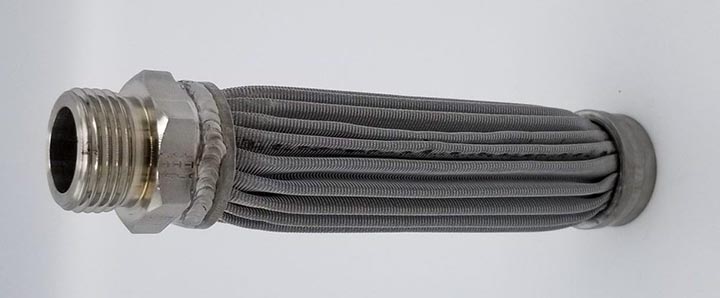
Is the Material Suitable for the Intended Processing?
Processing – that is, how easy or difficult it will be to turn a roll of woven wire mesh into a filter, and how many steps that will take – is key to filter design and mesh selection. There are innumerable ways that micron wire mesh can be shaped and mounted, so there is no comprehensive list of steps or a flow chart to follow to maximize manufacturability. However, there are a few areas to consider:
- The woven mesh strength is important. A paper-thin micron mesh screen will need to be supported.
- Select a mesh that will hold up to whatever forming and treating processes you will use to shape the filter mesh. If you press it into a shape, there will be some deformity of the open area. Is that acceptable? If the pleat has too sharp a crease will the mesh tear?
- How will the mesh be mounted and what edge treatments are needed in preparation for that? Epoxy, welding, over-molding, crimping?
- Will the mesh need heat treating to remove the possibility of the woven wire cold working during the forming process?
- If multiple layers of mesh are sintered, can the mesh be formed without delaminating it?
- Who will build the filter? Should you cut, form, and assemble all components in-house, or outsource some or all of the manufacturing so you can focus on the engineering?
When using wire cloth as the filtration media in filters, considering their processability and availability is the easiest path to manufacturing functional, durable, and cost-effective products.
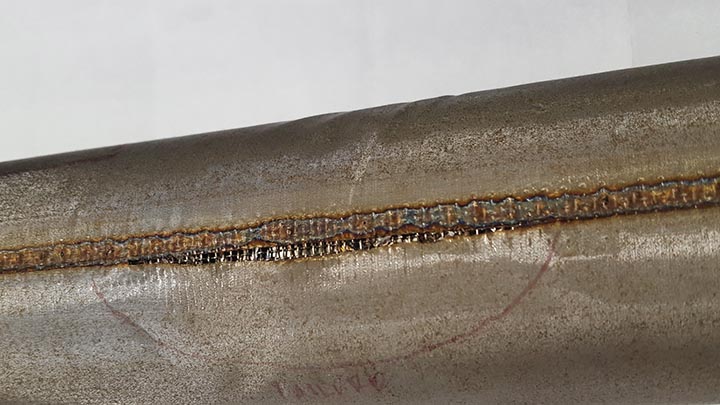
Wire Mesh Availability
Mesh screen manufacturers publish tables of all the products they are capable of weaving. What these tables do not often indicate, however, is how common those micron meshes are. While many highly respected mesh suppliers carry thousands of standard types in stock, the mesh an engineer specifies may not actually be on the shelf ready to ship. A knowledgeable mesh expert will be able to recommend one with similar properties that is more readily available.
With custom weaving, sourcing nearly any mesh is possible, but this comes at a cost. Collaboration with a mesh expert will help the designer source one that is the most suitable and cost effective for the intended application.
Conclusion
There’s nothing easy about designing filters from wire mesh. Perhaps the more experienced wire mesh filter designers know best what they don’t know. Rather than relying on data from tables, they have learned from prior experience that the shortest path to success is consulting with a wire mesh professional they trust to help nail down the difficult variables the material presents.


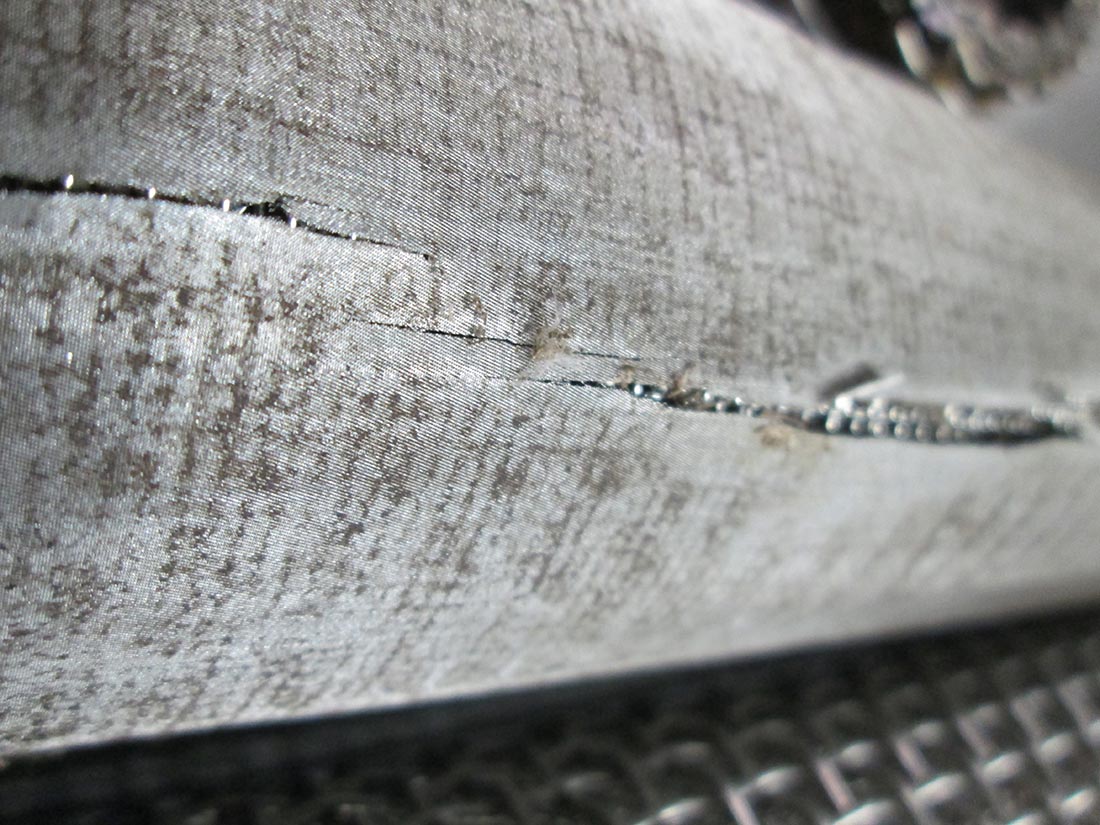
![Figure 1: Heat Exchanger Proventics GMBH.[22]](https://www.filtnews.com/wp-content/uploads/IFN_2_2024_crimpedmicrofiberyarns_Fig.-1-Heat-exchanger-225x125.jpg)

